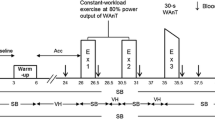Abstract
High arterial CO2 pressure (P aCO2) measured in athletes during exercise suggests inadequate hyperventilation. End-tidal CO2 pressure (P ETCO2) is used to estimate P aCO2. However, P ETCO2 also depends on exercise intensity (CO2 production, \( \dot V{\text{CO}}_2 \)) and ventilation efficiency (being P ETCO2 function of respiratory rate). We evaluated P ETCO2 as a marker, which combines efficiency of ventilation and performance. A total of 45 well-trained volunteers underwent cardiopulmonary tests and were grouped according to P ETCO2 at respiratory compensation (RC): Group 1 (P ETCO2 35.1–41.5 mmHg), Group 2 (41.6–45.7) and Group 3 (45.8–62.6). At anaerobic threshold, RC and peak exercise, ventilation (\( \dot V{\text{E}} \)) was similar, but in Group 3, a greater tidal volume (Vt) and lower respiratory rate (RR) were observed. Peak exercise workload and \( \dot V{\text{O}}_2 \) were lowest in Group 1 and similar between Group 2 and 3. Group 3 subjects also showed high peak \( \dot V{\text{CO}}_2 \) suggesting a greater glycolytic metabolism. In conclusion, a high P ETCO2 during exercise is useful in identifying a specific respiratory pattern characterized by high tidal volume and low respiratory rate. This respiratory pattern may belong to subjects with potential high performance.


Similar content being viewed by others
References
Beaver WR, Wasserman K, Whipp BJ (1986) A new method for detecting the anaerobic threshold by gas exchange. J Appl Physiol 60:2020–2027
Benallal H, Busso T (2000) Analysis of end-tidal and arterial PCO2 gradients using a breathing model. Eur J Appl Physiol 83(4–5):402–408
Clark JM, Hagerman FC, Gelfand R (1983) Breathing patterns during submaximal and maximal exercise in elite oarsmen. J Appl Physiol 55:440–446
Dempsey JA, Wagner PD (1999) Exercise-induced arterial hypoxemia. J Appl Physiol 87:1997–2006
Durand F, Mucci P, Prefaut C (2000) Evidence for an inadequate hyperventilation inducing arterial hypoxemia at submaximal exercise in all highly trained endurance athletes. Med Sci Sports Exer 32(5):926–932
Harms CA, Stager JM (1995) Low chemoresponsiveness and inadequate hyperventilation contribute to exercise-induced hypoxemia. J Appl Physiol 79:575–580
Harms CA, Babcock MA, McClaran SR et al (1997) Respiratory muscle work compromises leg blood flow during maximal exercise. J Appl Physiol 82(5):1573–1583
Harms CA, Wetter TJ, McClaran SR et al (1998) Effects of respiratory muscle work on cardiac output and its distribution during maximal exercise. J Appl Physiol 85(2):609–618
Harms CA, Wetterb TJ, St. Croix CM et al (2000) Effects of respiratory muscle work on exercise performance. J Appl Physiol 89:131–138
Johnson BD, Saupe KW, Dempsey JA (1992) Mechanical constraints on exercise hyperpnea in endurance athletes. J Appl Physiol 73:874–886
Jones NL, Robertson DG, Kane JW (1979) Difference between end-tidal and arterial PCO2 in exercise. J Appl Physiol 47(5):954–960
Martin BJ, Sparks KE, Zwillich CW et al (1979) Low exercise ventilation in endurance athletes. Med Sci Sports 11(2):181–185
Rodman JR, Haverkamp HC, Gordon SM et al (2002) Cardiovascular and respiratory system responses and limitations to exercise. In: Weisman IM, Zeballos RJ (eds) Clinical exercise testing. Prog Respir Res Karger, vol 32, Basel
Takano N, Inaishi S, Zhang Y (1997) Individual differences in breathlessness during exercise, as related to ventilatory chemosensitivities in humans. J Physiol 499.3:843–848
Wasserman K (1978) Breathing during exercise. Physiology in Medicine series. N Engl J Med 298:780–785
Wasserman K, Hansen JE, Sue DY et al. (2005) Normal values. Arterial and end-tidal carbon dioxide tensions. In: Wasserman K, Hansen JE, Sue DY et al (eds) Principles of exercise testing and interpretation, 4th edn. Lippincott Williams & Wilkins, Philadelphia
Acknowledgment
We are indebted to Prof. Brian Whipp for the constructive critiques during preparation of the manuscript.
Author information
Authors and Affiliations
Corresponding author
Rights and permissions
About this article
Cite this article
Bussotti, M., Magrì, D., Previtali, E. et al. End-tidal pressure of CO2 and exercise performance in healthy subjects. Eur J Appl Physiol 103, 727–732 (2008). https://doi.org/10.1007/s00421-008-0773-z
Accepted:
Published:
Issue Date:
DOI: https://doi.org/10.1007/s00421-008-0773-z




